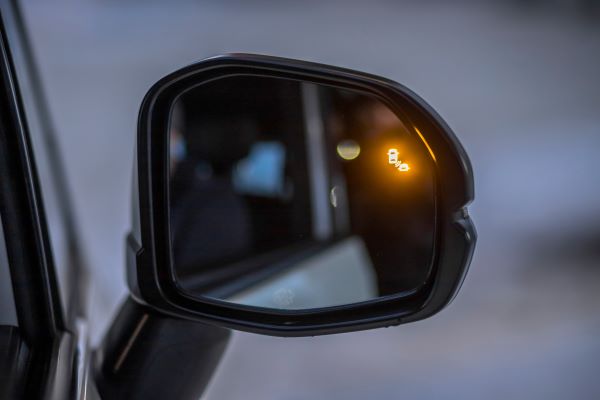What is blind spot monitoring?
Blind spot monitoring is a safety feature in vehicles that helps drivers be more aware of their surroundings. It uses sensors or cameras to detect objects in the driver’s blind spots, which are areas around the vehicle that cannot be easily seen through the rearview or side mirrors.
When an object is detected in the blind spot, the system typically alerts the driver with a visual or audible warning. This can help prevent accidents by notifying the driver of potential hazards when changing lanes or merging onto highways.
Blind spot monitoring systems are especially useful on larger vehicles like trucks and SUVs, where blind spots can be more significant. They can also be helpful for drivers with limited mobility or vision impairments.
Overall, blind spot monitoring is a valuable safety feature that can improve driver awareness and reduce the risk of collisions.
How blind spot monitoring works
Blind spot monitoring systems typically use sensors or cameras mounted on the sides of the vehicle to continuously monitor the areas around the car. These sensors can detect objects that are within a certain range and angle from the vehicle, such as other cars, pedestrians, or cyclists.
When a vehicle is detected in the blind spot, the system activates a warning signal to alert the driver.
Blind spot monitoring systems work by using sensors or cameras positioned on the sides of the vehicle to constantly scan the surrounding areas. These sensors are able to detect objects within a specific range and angle from the car, including other vehicles, pedestrians, or cyclists.
Once an object is detected in the blind spot, the system triggers a warning signal to notify the driver of the potential hazard. This alert can be visual, such as a light on the side mirrors or dashboard, or audible, such as a beep or chime.
Some blind spot monitoring systems also provide additional features, such as lane change assist, which can help guide the driver safely into the next lane by providing steering input if necessary.
Tips for Using Blind Spot Technology
Tips for Using Blind Spot Technology
1. Understand the limitations: While blind spot monitoring systems are incredibly helpful, it’s important to remember that they are not foolproof. Drivers should still check their mirrors and physically look over their shoulder before changing lanes or merging, even if the system does not detect any objects in the blind spot.
2. Keep sensors clean: Dust, dirt, snow, or ice can interfere with the sensors of the blind spot monitoring system, so it’s important to keep them clean and free of any obstructions.
3. Be aware of false alarms: Sometimes, the system may give off false alarms due to reflections or other factors. It’s important for drivers to be aware of this possibility and not solely rely on the system for safe driving.
4. Regularly check your blind spots: Even with blind spot monitoring, it’s still important to regularly check your blind spots manually before changing lanes or merging. This extra precaution can help ensure that you are aware of all potential hazards around your vehicle.
5. Practice safe driving habits: Blind spot monitoring is a great tool, but safe driving habits such as using turn signals, maintaining a safe following distance, and being attentive while driving are still crucial for overall safety on the road. By combining blind spot monitoring with these safe driving habits, drivers can help reduce the risk of accidents and stay alert to potential hazards.
Always get it recalibrated after an accident
If your vehicle has been involved in an accident, it is important to have the blind spot monitoring system recalibrated by a trained professional. Even minor collisions can cause damage to the sensors or cameras that may affect the accuracy of the system.
Getting the blind spot monitoring system recalibrated after an accident ensures that it is functioning properly and providing accurate information to help keep you safe on the road. By taking this extra precaution, you can ensure that your blind spot monitoring system is working as intended and providing you with the added safety and peace of mind while driving.
Final Thoughts
Blind spot monitoring systems are a valuable safety feature that can help drivers stay aware of their surroundings and reduce the risk of accidents. While these systems can provide an extra layer of protection, it’s important for drivers to remember that they are not a substitute for safe driving practices.
Drivers should always remain vigilant, check their blind spots manually, and practice safe driving habits while on the road.
Related Reading:
- Global Blind Spot Monitor Market Size is projected to reach (globenewswire.com)
- Blind Spot Monitor Market Size (gminsights.com)
- Are Blind Spot Monitors Worth the Extra Money? – Autotrader
- 5 Cars with Blind Spot Monitoring (msn.com)
Ohio Drivers: Contact Zanesville Autobody for Your Auto Body Repair
This article was originally published by Zanesville Autobody Collision and Glass, LLC, a member of the Autobody of Ohio family of auto body shops. If you are in Ohio and looking for a quality autobody shop “near me”, we are here to help you. We’ll make your car like new again!
Zanesville Autobody Collision and Glass
1152 Newark Road
Zanesville, Ohio 43701
Phone: (740) 487-3111
Fax: (740) 888-3500

